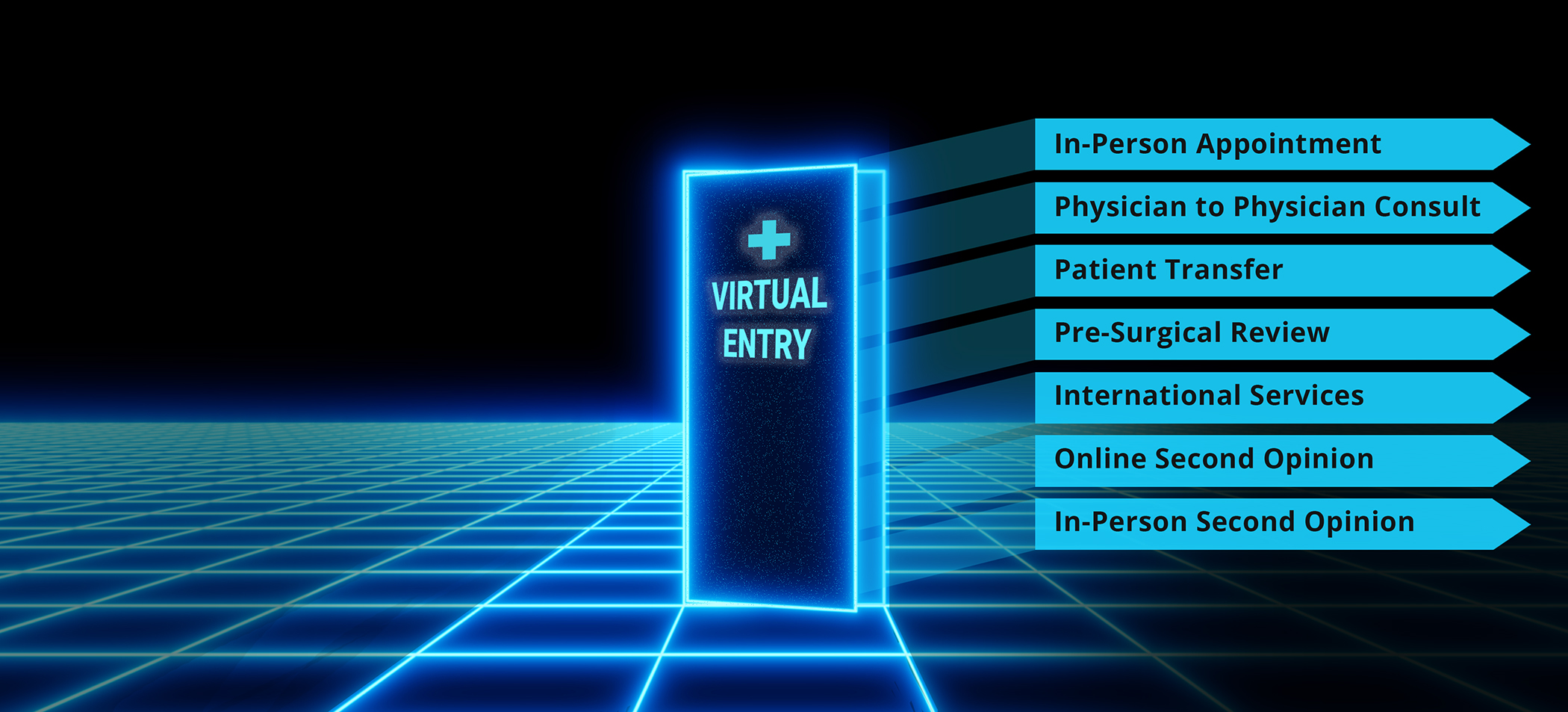Welcome to the 'Virtual Front Door'

Anisette has been diagnosed as having early-onset Parkinson’s Disease. She knows this is a difficult condition to diagnose correctly and that its repercussions will change her life. While she holds her physician who gave her the diagnosis in high regard, she recalls that one of her friends had an acquaintance that had been misdiagnosed and wants to be sure. Like most people, Anisette immediately goes online to try to understand her options, searching not only for information, but clarity and understanding. For Anisette, it’s imperative to ensure that she has taken every practical step in her own healthcare journey.
Over the last decade, the opportunities for patients seeking online information for a medical condition have greatly changed. Almost 3/4 will do their initial investigation online. Many seek out top specialists and programs in their particular field, but inevitably, experts are not always located nearby. Digital solutions can open access to patients who live anywhere with wifi.
A Better Intake Process
Forward thinking healthcare institutions are building an online or virtual doorway for their patients. A virtual front door allows a patient to receive initial advice and guidance on their case prior to the burden of traveling, while also allowing the hospital to preview and plan for the patient heading their way. For patients that are in pain, immunocompromised, traveling with children, or all of the above, public airports and long hours in the car are not ideal. While patients could still choose to travel in person for that first visit, the virtual front door provides a more convenient and sometimes safer alternative.
The online process usually begins with a simple intake. Soon after, someone within the institution or supporting services directs the patient to the appropriate department or communicates if none of the online appointment types are appropriate. If medical records are needed, the patient can upload directly, as well as request their medical records from another hospital or practice within a secure online portal. Here, all relevant documents along with notes and questions surrounding the case are collected and organized. Administrators who monitor and guide some of these processes can categorize cases and distribute them to the appropriate divisions of the hospital. Some hospitals have a specific process for patient transfers, international patients and second opinions; in others, these processes may vary by division.
Sometimes patients just want to know if they should come in-person. Using this brief intake to make the initial decision ensures they don’t waste time. An increasing number of patients who use second opinion programs to obtain written opinions on an existing case through a virtual front door process later decide to complete a procedure or treatment with the institution.
Added Flexibility to the Physician’s Workflow
The electronic portal at the hospital enables the expert physician to review the patient’s case history and medical records asynchronously and then respond with a prescribed course of action. Typically, this takes one of three forms:
(a) The specialist may simply schedule a telehealth visit with the patient to discuss their findings. Not every complex case is appropriate for this alternative, but it may be a good starting point, or
(b) The physician may be able to do an in-depth review of the patient’s prior medical tests and records and form an opinion that can be issued in written form. This is generally known as a virtual or online second opinion. This is a great way to access the deep specialized knowledge and experience of physician who is located far from a patient, or
(c) When the situation arises that the physician believes they can help the patient most efficiently in person, the result of this remote electronic review may be to request that the patient visit. If they do, this initial intake enables the physician to be prepared for the specifics of a procedure or other treatment prior to the patient’s arrival and ensures efficient advance scheduling, resulting in a better experience for the patient, the physician and the facility.
It Pays to Prepare Ahead
Implementation of a “virtual” front door saves time, minimizes patient inconvenience and streamlines any resulting patient-physician encounter.
How many times have you shown up at a specialist’s office expecting your records to have preceded you, and wound up waiting while your physician searched for the communication with your original treating physician? How many expensive and invasive duplicate tests have you encountered that could have easily been avoided if your medical records were made available in advance?
The remote portal enables the patient to filter their requests in the hopes of identifying the most convenient and advantageous pathway. As a physician, it enables an efficient screening process for patients, diverting those that are a poor fit for the specialties and level of care available. Collecting patient records in advance ensures that scarce clinicians are not called upon when not needed and that patients are not frustrated by unproductive in-person visits.
Similarly, there is nothing more frustrating for a sick patient than showing up at your facility only to be subjected to the completion of a ream of manual paper forms on a clipboard. Most of the information you are requesting could have been added in advance, via an online self-service portal and attached to the existing records. This automated process saves time and money for the hospital and reduces the risk of error from the input process.
Even pre-surgical reviews can be accomplished remotely prior to patient visits. This allows doctors to ensure that scheduled surgeries are, in fact, necessary and appropriate, preventing “white space” on the surgical suite calendar and saving your hospital thousands of dollars of missed opportunity cost.
By establishing a single electronic front door and directing all of your patients through it, patients, health insurance carriers, hospital staff, physicians, and even the bottom line can all benefit.
Interested in learning more? Read the Advisory's Board's Remote Second Opinion Maturity Model



